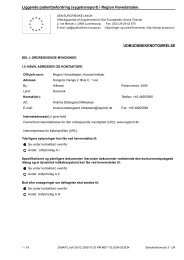Territorial Review Copenhagen - Region Hovedstaden
Territorial Review Copenhagen - Region Hovedstaden
Territorial Review Copenhagen - Region Hovedstaden
Create successful ePaper yourself
Turn your PDF publications into a flip-book with our unique Google optimized e-Paper software.
70<br />
Attraction of high-skilled people<br />
Denmark has fewer international students than many other OECD<br />
countries, with only 4.4% in tertiary education in 2005, against 6.7% in the<br />
OECD as a whole. <strong>Copenhagen</strong> scores somewhat higher than the national<br />
average, and the University of <strong>Copenhagen</strong> includes 6% foreign students,<br />
but this is still low from an international perspective. 22 The IT University of<br />
<strong>Copenhagen</strong>, with 32% foreign students, is an exception, but its student<br />
body represents a very small part of students in <strong>Copenhagen</strong>. A similar<br />
pattern can be found with respect to foreigners engaged in research:<br />
foreigners‘ participation in advanced research programmes was 6.9% in<br />
Denmark, but 16.5% in the OECD countries as a whole. The increase in the<br />
number of foreign students has been slower than on average in the OECD:<br />
the share of international students in Denmark has increased 35% over the<br />
period from 2000 to 2005, as compared with 49% in the whole of the OECD<br />
(OECD, 2008). Inflows of foreign students appear to be important in<br />
attracting highly skilled people: research on the United States over the<br />
period 1971-2001 suggested that the number of foreign students is an<br />
important predictor of subsequent migration (Dreher and Poutvaara, 2005).<br />
This is all the more important for Denmark and <strong>Copenhagen</strong> given the<br />
labour market shortages.<br />
<strong>Copenhagen</strong> attracts relatively few foreign workers by comparison with<br />
other cities in the world. Its share of foreign population is relatively low and<br />
dominated by non-Western immigrants who came to Denmark as refugees<br />
or in the context of family reunification, rather than because of their skills or<br />
the needs of the domestic labour market. The flows of highly skilled<br />
immigrants into <strong>Copenhagen</strong> are limited. The current relative inflows of<br />
foreign nationals into Denmark are close to the average in the OECD, an<br />
inflow of 39 immigrants per 1 000 of population in 2006. Recent years have<br />
seen an increase, with a 21% growth in inflows over 2003-06, as compared<br />
with only 5% in the OECD as a whole. The inflow to Denmark in 2006<br />
amounted to 21 700 people, but not all of these were admitted for workrelated<br />
reasons. Although this inflow is higher than in previous years, it is<br />
lower than the inflow before 2003 (OECD, 2008).<br />
Relatively few of the foreigners that Denmark attracts are highly skilled.<br />
Although the number of work permits has increased over the last decade,<br />
and inflows of immigrants are directed more towards labour market needs,<br />
the share of high-skilled labour flows remains average, with many of these<br />
permits given within the construction sector. Denmark‘s share of immigrants<br />
with tertiary education is 19%, as compared with 25% in the OECD as a<br />
whole. Among OECD countries, Denmark has one of the lowest rates of<br />
employed professional and technical migrants as a percentage of total<br />
employed professionals and technicians (OECD, 2008), and is not among

















